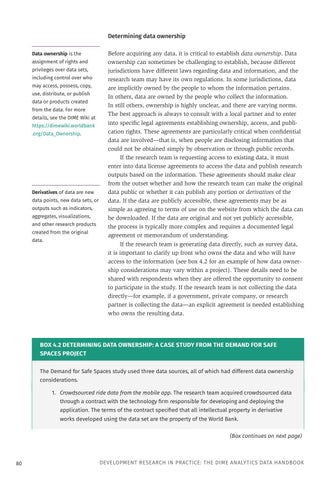Determining data ownership Data ownership is the assignment of rights and privileges over data sets, including control over who may access, possess, copy, use, distribute, or publish data or products created from the data. For more details, see the DIME Wiki at https://dimewiki.worldbank .org/Data_Ownership.
Derivatives of data are new data points, new data sets, or outputs such as indicators, aggregates, visualizations, and other research products created from the original data.
Before acquiring any data, it is critical to establish data ownership. Data ownership can sometimes be challenging to establish, because different jurisdictions have different laws regarding data and information, and the research team may have its own regulations. In some jurisdictions, data are implicitly owned by the people to whom the information pertains. In others, data are owned by the people who collect the information. In still others, ownership is highly unclear, and there are varying norms. The best approach is always to consult with a local partner and to enter into specific legal agreements establishing ownership, access, and publication rights. These agreements are particularly critical when confidential data are involved—that is, when people are disclosing information that could not be obtained simply by observation or through public records. If the research team is requesting access to existing data, it must enter into data license agreements to access the data and publish research outputs based on the information. These agreements should make clear from the outset whether and how the research team can make the original data public or whether it can publish any portion or derivatives of the data. If the data are publicly accessible, these agreements may be as simple as agreeing to terms of use on the website from which the data can be downloaded. If the data are original and not yet publicly accessible, the process is typically more complex and requires a documented legal agreement or memorandum of understanding. If the research team is generating data directly, such as survey data, it is important to clarify up front who owns the data and who will have access to the information (see box 4.2 for an example of how data ownership considerations may vary within a project). These details need to be shared with respondents when they are offered the opportunity to consent to participate in the study. If the research team is not collecting the data directly—for example, if a government, private company, or research partner is collecting the data—an explicit agreement is needed establishing who owns the resulting data.
BOX 4.2 DETERMINING DATA OWNERSHIP: A CASE STUDY FROM THE DEMAND FOR SAFE SPACES PROJECT The Demand for Safe Spaces study used three data sources, all of which had different data ownership considerations. 1. Crowdsourced ride data from the mobile app. The research team acquired crowdsourced data through a contract with the technology firm responsible for developing and deploying the application. The terms of the contract specified that all intellectual property in derivative works developed using the data set are the property of the World Bank. (Box continues on next page)
80
DEVELOPMENT RESEARCH IN PRACTICE: THE DIME ANALYTICS DATA HANDBOOK





